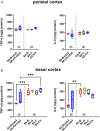Effect of isolated intracranial hypertension on cerebral perfusion within the phase of primary disturbances after subarachnoid hemorrhage in rats
- PMID: 37502465
- PMCID: PMC10368889
- DOI: 10.3389/fncel.2023.1115385
Effect of isolated intracranial hypertension on cerebral perfusion within the phase of primary disturbances after subarachnoid hemorrhage in rats
Abstract
Introduction: Elevated intracranial pressure (ICP) and blood components are the main trigger factors starting the complex pathophysiological cascade following subarachnoid hemorrhage (SAH). It is not clear whether they independently contribute to tissue damage or whether their impact cannot be differentiated from each other. We here aimed to establish a rat intracranial hypertension model that allows distinguishing the effects of these two factors and investigating the relationship between elevated ICP and hypoperfusion very early after SAH.
Methods: Blood or four different types of fluids [gelofusine, silicone oil, artificial cerebrospinal fluid (aCSF), aCSF plus xanthan (CX)] were injected into the cisterna magna in anesthetized rats, respectively. Arterial blood pressure, ICP and cerebral blood flow (CBF) were continuously measured up to 6 h after injection. Enzyme-linked immunosorbent assays were performed to measure the pro-inflammatory cytokines interleukin 6 (IL-6) and tumor necrosis factor α (TNF-α) in brain cortex and peripheral blood.
Results: Silicone oil injection caused deaths of almost all animals. Compared to blood, gelofusine resulted in lower peak ICP and lower plateau phase. Artificial CSF reached a comparable ICP peak value but failed to reach the ICP plateau of blood injection. Injection of CX with comparable viscosity as blood reproduced the ICP course of the blood injection group. Compared with the CBF course after blood injection, CX induced a comparable early global ischemia within the first minutes which was followed by a prompt return to baseline level with no further hypoperfusion despite an equal ICP course. The inflammatory response within the tissue did not differ between blood or blood-substitute injection. The systemic inflammation was significantly more pronounced in the CX injection group compared with the other fluids including blood.
Discussion: By cisterna magna injection of blood substitution fluids, we established a subarachnoid space occupying rat model that exactly mimicked the course of ICP in the first 6 h following blood injection. Fluids lacking blood components did not induce the typical prolonged hypoperfusion occurring after blood-injection in this very early phase. Our study strongly suggests that blood components rather than elevated ICP play an important role for early hypoperfusion events in SAH.
Keywords: animal model; cerebral autoregulation; cerebral blood flow; early brain injury; inflammation; intracranial hypertension; rat; subarachnoid hemorrhage.
Copyright © 2023 Hao, Conzen-Dilger, Schmidt, Harder, Schöps, Clauser, Schubert and Lindauer.
Conflict of interest statement
The authors declare that the research was conducted in the absence of any commercial or financial relationships that could be construed as a potential conflict of interest.
Figures








Similar articles
-
Clazosentan, an endothelin receptor antagonist, prevents early hypoperfusion during the acute phase of massive experimental subarachnoid hemorrhage: a laser Doppler flowmetry study in rats.J Neurosurg. 2008 Dec;109(6):1134-40. doi: 10.3171/JNS.2008.109.12.1134. J Neurosurg. 2008. PMID: 19035733
-
The Acute Phase of Experimental Subarachnoid Hemorrhage: Intracranial Pressure Dynamics and Their Effect on Cerebral Blood Flow and Autoregulation.Transl Stroke Res. 2019 Oct;10(5):566-582. doi: 10.1007/s12975-018-0674-3. Epub 2018 Nov 15. Transl Stroke Res. 2019. PMID: 30443885
-
The Role of Intracranial Pressure and Subarachnoid Blood Clots in Early Brain Injury After Experimental Subarachnoid Hemorrhage in Rats.World Neurosurg. 2019 Sep;129:e63-e72. doi: 10.1016/j.wneu.2019.05.009. Epub 2019 May 15. World Neurosurg. 2019. PMID: 31100532
-
Experimental subarachnoid hemorrhage: subarachnoid blood volume, mortality rate, neuronal death, cerebral blood flow, and perfusion pressure in three different rat models.Neurosurgery. 2003 Jan;52(1):165-75; discussion 175-6. doi: 10.1097/00006123-200301000-00022. Neurosurgery. 2003. PMID: 12493115
-
[Opioids, cerebral circulation and intracranial pressure].Anaesthesist. 1994 Jul;43(7):421-30. doi: 10.1007/s001010050074. Anaesthesist. 1994. PMID: 8092451 Review. German.
Cited by
-
Protective effects of flavonoids against intracerebral and subarachnoid hemorrhage (Review).Exp Ther Med. 2024 Jul 4;28(3):350. doi: 10.3892/etm.2024.12639. eCollection 2024 Sep. Exp Ther Med. 2024. PMID: 39071910 Free PMC article. Review.
References
LinkOut - more resources
Full Text Sources

